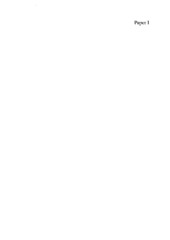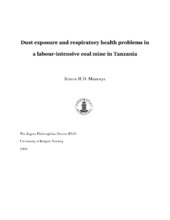| dc.contributor.author | Mamuya, Simon H. D. | en_US |
| dc.date.accessioned | 2006-12-11T18:06:38Z | |
| dc.date.available | 2006-12-11T18:06:38Z | |
| dc.date.issued | 2006-12-05 | eng |
| dc.identifier.isbn | 82-308-0198-3 (print version) | en_US |
| dc.identifier.uri | https://hdl.handle.net/1956/2002 | |
| dc.description.abstract | Dust exposure and respiratory health problems were studied among randomly selected workers in a coal mine in Tanzania. The aim of the study was to assess the personal respirable dust and quartz exposure and the prevalence of respiratory problems and to present recommendations on how to improve the situation. An epidemiological cross-sectional study was carried out at the Kiwira Coal Mine in Tanzania. Dust exposure was measured during two periods in 2003 and 2004. In total, 204 dust samples were taken from 141 workers. The surveys involved 299 workers randomly selected from 8 job teams including development, mine, underground maintenance, underground transport, washing plant, boiler and turbine, ash and cinders and office workers. The study conducted a face-to-face standardized interview to collect information on demographic characteristics, work history, previous diseases, acute respiratory symptoms, chronic respiratory symptoms and smoking habits. Lung functioning was assessed using a Vitalograph Alpha III portable spirometer according to American Thoracic Society (1995) recommendations. Personal respirable dust was sampled using a SKC Sidekick pump with a flow rate of 2.2 l · min–1. Respirable dust samples were analysed for quartz by X-ray diffraction on a silver membrane filter using the US National Institute for Occupational Health and Safety method 7500. The individual cumulative exposure to respirable dust or quartz (mg · year · m–3) for each worker was estimated. Nitrogen dioxide (NO2), ammonia (NH3), carbon monoxide (CO) and sulphur dioxide (SO2) gas concentrations were assessed using electrochemical sensors (Dräger PAC III) and using Dräger detector tubes. The statistical methods used in analysing the data included Student’s t-test, analysis of variance, the chi-square test, multiple linear regression models, logistic regression modelling and one- and two-way random effects models. The workers in the development team had the highest exposure to respirable dust and quartz (geometric means 1.80 mg · m–3 and 0.073 mg · m–3, respectively). The percentages of samples exceeding the threshold limit values of 0.9 mg · m–3 for respirable (bituminous) coal dust and 0.05 mg · m–3 for respirable quartz, respectively, were higher in the development team (55% and 47%) than in the mining team (20% and 9%). Drilling in the development team was the work task associated with the highest exposure to respirable dust and quartz (17.37 mg · m–3 and 0.611 mg · m–3, respectively). The exposure models for the development section showed that blasting and pneumatic drilling time were the major determinants of respirable dust and quartz, explaining 45.2% and 40.7% of the variance, respectively. In the mining team, only blasting significantly determined respirable dust. For most a priori job teams, the within-worker variance component was considerably higher than the between-worker variance component. The high contrast in exposure between the teams together with the estimated low attenuation of the theoretical curve led to the conclusion that grouping by job team would be appropriate for studying the association between current dust exposure and respiratory effects. Based on the estimated worker-specific mean exposure in the job teams and the job history, the arithmetic mean cumulative exposure for workers who participated in the epidemiological part of the study was 38.1 mg · year · m–3 for respirable dust and 2.0 mg · year · m–3 for quartz. The prevalence of the ratio of forced expiratory volume in 1 second (FEV1) to forced vital capacity (FVC) being less than 0.7 among the workers was 17.3%. Workers in the development team (20.5%) had the highest prevalence of FEV1% <80%. The estimates of the effects of cumulative exposure on FEV1/FVC were 0.015% per (mg · year · m–3) for respirable dust and –0.3% per (mg · year · m–3) for respirable quartz. In logistic regression models, the odds ratios for airway limitation (FEV1/FVC <0.7) for the workers in the highest decile of cumulative dust and quartz exposure versus the referents were 4.36 (95% confidence interval (CI): 1.06, 17.96) for dust and 3.49 (95% CI 0.92, 13.21) for quartz. The upper 10% of workers grouped by cumulative dust and quartz exposure also had higher odds ratios (OR) for predicted FEV1% <80% than the reference group OR: 10.38 (95% CI 1.38, 78.13) for dust and 14.18 (95% CI 1.72, 116.59) for quartz. The workers from the development team had a higher self-reported prevalence of acute symptoms of breathlessness (OR = 2.96, 95% CI 1.44–6.11) and blocked nose (OR = 2.47, 95% CI 1.10–5.56) than the other production workers. In addition, development workers had more chronic symptoms of breathlessness (17.0%) than the other production workers (3.9%) (P = 0.001). The highest decile of exposure to respirable dust was associated with cough (OR = 2.91, 95% CI 1.06–7.97), as was the highest decile of exposure to respirable quartz (OR = 2.87 (95% CI 1.05, 7.88), compared with the reference. This study showed that workers in a coal mine are exposed to high levels of respirable dust and quartz, especially drillers and blasters. This study also showed that the development workers had more acute and chronic respiratory symptoms than other production workers. It also revealed an exposure–response relationship between respirable coal mine dust and quartz and airway limitation measured by spirometry. Immediate actions that could improve the situation include implementing effective dust control together with improved training and education programmes for the workers. Priority should be given to workers performing drilling and blasting in the development sections of the mine. Further needs include policies on exposure and health surveillance and appropriate enforcement mechanisms in Tanzania. | en_US |
| dc.format.extent | 1237189 bytes | eng |
| dc.format.extent | 690187 bytes | eng |
| dc.format.extent | 742911 bytes | eng |
| dc.format.extent | 1067337 bytes | eng |
| dc.format.extent | 877841 bytes | eng |
| dc.format.mimetype | application/pdf | eng |
| dc.format.mimetype | application/pdf | eng |
| dc.format.mimetype | application/pdf | eng |
| dc.format.mimetype | application/pdf | eng |
| dc.format.mimetype | application/pdf | eng |
| dc.language.iso | eng | eng |
| dc.publisher | The University of Bergen | eng |
| dc.relation.haspart | Paper I: Annals of Occupational Hygiene 50(2), Mamuya, Simon H. D.; Bråtveit, Magne; Mwaiselage, Julius; Mashalla, Yohana J. S. & Bente E. Moen, High Exposure to Respirable Dust and Quartz in a Labour-intensive Coal Mine in Tanzania, pp. 197-204. Copyright 2006 British Occupational Hygiene Society, Oxford University Press. Reproduced with permission. Published version. The published version is also available at: <a href="http://dx.doi.org/10.1093/annhyg/mei052" target="blank"> http://dx.doi.org/10.1093/annhyg/mei052</a> | en_US |
| dc.relation.haspart | Paper II: Annals of Occupational Hygiene 50(7), Mamuya, Simon H. D.; Bråtveit, Magne; Mwaiselage, Julius and Bente E. Moen, Variability of exposure and estimation of cumulative exposure in a manually operated coal mine, pp. 737-745. Copyright 2006 British Occupational Hygiene Society, Oxford University Press. Reproduced with permission. Published version. The published version is also available at: <a href="http://dx.doi.org/10.1093/annhyg/mel031" target="blank"> http://dx.doi.org/10.1093/annhyg/mel031</a> | en_US |
| dc.relation.haspart | Paper III: International Archives of Occupational and environmental Health 80(7), Mamuya, Simon H. D.; Bråtveit, Magne; Mashalla, Yohana J. S. and Bente E. Moen, Airflow limitation among workers in a labour-intensive coal mine in Tanzania, pp. 567-575. Copyright 2007 Springer Verlag. Reproduced with permission. Submitted version. The published version is available at: <a href="http://dx.doi.org/10.1007/s00420-006-0167-7" target="blank"> http://dx.doi.org/10.1007/s00420-006-0167-7</a> | en_US |
| dc.relation.haspart | Paper IV: BMC public Health 7(17), Mamuya, Simon H. D.; Bråtveit, Magne; Mashalla, Yohana J. S. and Bente E. Moen, High prevalence of respiratory symptoms among workers in the development section of a manually operated coal mine in a developing country: A cross sectional study. Copyright 2007 Mamuya et al; licensee BioMed Central Ltd. Reproduced with permission. Submitted version. The published version is available at: <a href="http://dx.doi.org/10.1186/1471-2458-7-17" target="blank"> http://dx.doi.org/10.1186/1471-2458-7-17</a> | en_US |
| dc.title | Dust exposure and respiratory health problems in a labour-intensive coal mine in Tanzania | en_US |
| dc.type | Doctoral thesis | |
| dc.subject.nsi | VDP::Medisinske Fag: 700::Helsefag: 800 | nob |




